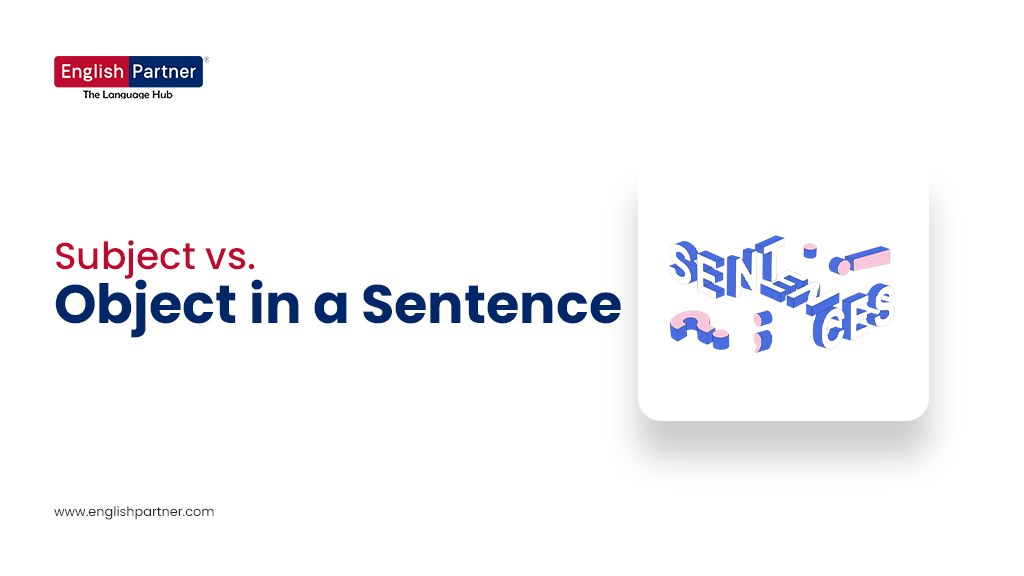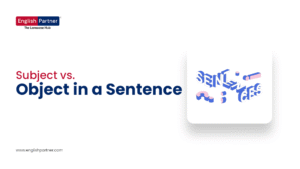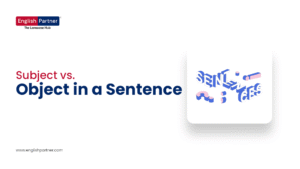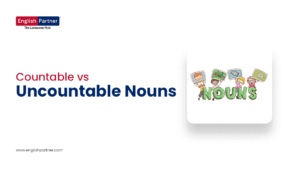Your mom comes and tells you : “Me went to the market.”
You will probably understand her, but it sounds strange… even wrong.
Why? Because in English, “me” is not the subject. The subject is the one who does the action, and in this case, it should be “I went to the market.”
Sometimes we use subject words (I, he, she, they) when we should use object words (me, him, her, them) and the other way around.
Once you know the simple difference between subject and object, you’ll avoid these mistakes and sound much more natural when you speak.
At English Partner, we explain such grammar ideas with easy, real-life examples. In this blog, you’ll learn to quickly identify:
- Who is doing the action (subject), and
- Who is receiving the action (object).
The Heart of a Sentence
Every English sentence has two main players:
- The Doer → the one who performs the action (Subject)
- The Receiver → the one who receives the action (Object)
Think of it like a cricket match:
- The batsman hits the ball → Batsman = Subject
- The ball receives the hit → Ball = Object
Or like a simple story:
The dog chased the cat.
- Dog = Subject (doer)
- Cat = Object (receiver)
Without a subject and object, a sentence feels incomplete. One gives the action, the other gives the meaning.
Understanding the Subject (Doer of the Action)
The subject is the part of the sentence that tells us who or what is doing the action. Think of it as the hero of the sentence.
Simple Daily-Life Examples
- The teacher explains the lesson. → The teacher = Subject
- Ravi plays football every evening. → Ravi = Subject
- The dog barked loudly. → The dog = Subject
A quick trick: Ask yourself, “Who is doing the action?”
The answer is always the subject.
More Than Just People
- The sun shines brightly. → The sun = Subject
- Honesty is important. → Honesty = Subject (an idea, not a person!)
Understanding the Object (Receiver of the Action)
The object is the part of the sentence that tells us who or what receives the action. If the subject is the hero, then the object is the one who feels the effect of the hero’s action.
Simple Daily-Life Examples
- Ravi plays football. → Football = Object
- The teacher helps students. → Students = Object
- The dog chased the cat. → The cat = Object
A quick trick: Ask “Who or what is receiving the action?” → That’s the object.
Objects Can Be Things or People
- She loves music. → Music = Object
- He invited me to the party. → Me = Object
Spot the Action Flow
One of the easiest ways to understand subject and object is to see the action flow in a sentence.
Think of it like an arrow:
Subject → Verb → Object
Examples
The boy kicks the ball.
- Subject = The boy (doer)
- Verb = kicks (action)
- Object = The ball (receiver)
→ Flow: Boy → kicks → Ball
The teacher praised the student.
- Subject = The teacher
- Verb = praised
- Object = The student
→ Flow: Teacher → praised → Student
She gave him a gift.
Subject = She
Verb = gave
Objects = Him (indirect), a gift (direct)
→ Flow: She → gave → Him → Gift
Mistakes to Avoid
Even if you know the basic difference between subject and object, it’s very easy to slip up while speaking. Here are some common mistakes learners make 👇
1. Wrong Pronoun Choice
- Wrong: Me like apples.
- Correct: I like apples.
“I” is the subject form, while “me” is the object form.
2. Mixing Subject and Object Position
- Wrong: Him gave I a pen.
- Correct:He gave me a pen.
The subject must always come before the verb.
3. Dropping the Object
- Wrong: She bought. (incomplete if verb needs an object)
- Correct:She bought a dress.
Some verbs need objects to make sense.
4. Direct Translation Errors
Sometimes learners translate directly from their mother tongue, leading to subject/object mix-ups. Example:
- Wrong: To him I chocolates gave.
- Correct: I gave him chocolates.
Fun Practice Game
Let’s play a quick game to test your understanding of subjects and objects. Fill in the blanks and then check the answers below.
Questions
- _____ reads a book. (Who is the subject here?)
- The dog chased ____. (Who is the object here?)
- My father bought ____ a gift. (Who received the action?)
- _____ runs fast. (Who is doing the action?)
- The teacher teaches ____. (Who receives the teaching?)
Answers
- He/She/John (Subject = the doer)
- the cat / me / him (Object = the receiver)
- me / her / us (Object = receiver of “bought”)
- The boy / She / He (Subject = the runner)
- students / us / them (Object = the learners)
Pro Tip: Turn this into a daily habit—pick any sentence you hear, and quickly ask yourself: Who is doing the action? Who is receiving it?
This is exactly how learners practice in English Partner’s spoken English course online, where simple exercises turn into confident speaking skills.
Everyday Dialogues: Spot the Subject and Object
Let’s look at a few short conversations. Try to identify the subject (doer) and object (receiver) in each one
A: Who called you?
B: My sister called me.
SubjDialogue 1
- ect = My sister
- Object = Me
Dialogue 2
A: Did you see him?
B: Yes, I saw him at the park.
- Subject = I
- Object = Him
Dialogue 3
A: What did your teacher give you?
B: The teacher gave me homework.
- Subject = The teacher
- Object = Me, homework
Dialogue 4
A: Who helped them?
B: We helped them yesterday.
- Subject = We
- Object = Them
Notice This:
Subject pronouns = I, he, she, we, they.
Object pronouns = me, him, her, us, them.
Wrapping Up
Understanding subject and object is like learning who the hero is and who is affected by the hero’s action in every sentence.
Quick Recap:
- Subject = The doer of the action (I, he, she, we, they).
- Object = The receiver of the action (me, him, her, us, them).
Example: The cat chased the mouse.
- Cat = Subject
- Mouse = Object
Once you practice spotting subjects and objects, your sentences will sound clearer, more natural, and more confident.
At English Partner, we believe grammar should be simple and practical. That’s why our spoken English course online is designed with real-life examples and conversations, making us one of the best online spoken English classes in India.
Vishaleni

Frequently Asked question?
The subject is the doer of the action. Example: The boy runs. → Boy = Subject.
The object is the receiver of the action. Example: The boy kicks the ball. → Ball = Object.
Yes, it depends on the sentence.
- I called him. → “I” = subject, “him” = object.
- He called me. → “He” = subject, “me” = object.
Notice how pronouns change depending on their role.
Yes! Example: She gave me a pen.
- Indirect object = Me (who received it)
- Direct object = A pen (what was given)
Remember:
Subjects are usually I, he, she, we, they
Objects are usually me, him, her, us, them
Quick trick: If you can add a number (two, three, four…) or a/an before it, it’s usually countable. If not, it’s uncountable.













